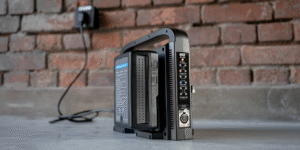In a world filled with constant background noise—from busy streets to buzzing offices—having a noise canceling microphone on your headphones is no longer just a luxury; it’s a necessity. Whether you’re taking business calls, recording podcasts, streaming games, or simply trying to enjoy clear conversations, the right type of noise canceling microphone can make a world of difference.
However, not all noise canceling microphones are the same. They use different technologies, designs, and processing methods to filter out unwanted sounds while capturing your voice clearly. Understanding the three main types can help you choose the right headphones for your needs.
In this article, we’ll explore:
- Passive Noise Canceling Microphones
- Active Noise Canceling Microphones
- Environmental Noise Canceling (ENC) Microphones
We’ll break down how each works, their pros and cons, and which scenarios they’re best suited for.
1. Passive Noise Canceling Microphones
What It Is:
Passive noise cancelation relies on physical design rather than electronic processing to block out background noise. This includes:
- Foam or leather ear cup padding to seal the ears.
- Microphone housings designed to block ambient sounds.
- Directional microphone pickup patterns that focus on your voice.
How It Works:
The microphone captures audio in a way that naturally rejects off-axis sounds (sounds not coming from your mouth). Combined with earcups that isolate your ears from environmental noise, it reduces what you hear and what gets transmitted.
Example Use Cases:
- Over-ear gaming headsets with cardioid or unidirectional mics.
- Call center headsets with microphone windshields.
- Podcast recording in relatively quiet rooms.
Pros:
- No battery or power needed for noise canceling.
- Less expensive compared to active systems.
- Reliable and simple—fewer electronic parts to fail.
- Works well in moderately noisy environments.
Cons:
- Less effective in extremely loud surroundings.
- Cannot adapt to sudden changes in background noise.
- Limited to the physical capabilities of the headset design.
Best For:
Users in relatively controlled environments—home offices, small studios, or indoor gaming setups—who want affordable clarity without advanced electronics.
2. Active Noise Canceling (ANC) Microphones
What It Is:
Active noise canceling uses electronic circuitry to reduce unwanted noise before it reaches your ears or before your voice reaches the listener.
How It Works:
- Built-in microphones capture ambient noise.
- The headset generates an “anti-noise” signal—a sound wave with the opposite phase—which cancels out the original noise.
- In microphones, this can also mean filtering your outgoing voice signal to remove environmental noise before it reaches the listener.
Example Use Cases:
- Premium travel headphones like Bose or Sony models.
- Professional headsets for pilots or industrial workers.
- Video conferencing headsets in noisy environments.
Pros:
- Significantly reduces consistent, low-frequency background noise (engine hum, air conditioning).
- Improves voice clarity for the listener.
- Works even in very noisy spaces.
Cons:
- Requires power (battery or USB).
- Can introduce slight audio delay in cheaper models.
- Less effective against sudden, unpredictable sounds.
- Higher cost.
Best For:
Professionals or travelers who work in loud, consistent noise environments—airports, factories, trains—where blocking out low-frequency noise is essential.
3. Environmental Noise Canceling (ENC) Microphones
What It Is:
ENC is a digital processing technology that focuses on your outgoing audio signal—making your voice crystal clear to others, regardless of how noisy your surroundings are.
How It Works:
- Multiple microphones pick up both your voice and environmental sounds.
- AI-powered algorithms analyze the audio and remove background noises while preserving your voice.
- The processed, clean signal is sent to the other party.
Example Use Cases:
- Wireless earbuds with call-focused microphones (e.g., AirPods Pro, JBL Live series).
- Streaming and gaming headsets used in open environments.
- Online teaching and remote work in busy households.
Pros:
- Dramatic improvement in how others hear you, even in chaos.
- Works well for unpredictable noises (dogs barking, keyboards clicking, traffic).
- Often paired with Bluetooth and wireless convenience.
Cons:
- Primarily improves outgoing audio (your listeners benefit, but you may still hear noise unless combined with ANC).
- May slightly alter voice tone depending on processing quality.
- Relies heavily on AI algorithm accuracy.
Best For:
Anyone making frequent calls, streaming, or teaching online in noisy, unpredictable environments—especially with wireless headphones.
Comparing the Three Types
| Feature | Passive NC Mic | Active NC Mic | ENC Mic |
| Noise Reduction Method | Physical design | Anti-noise sound waves | Digital AI processing |
| Power Required | No | Yes | Yes |
| Best At Reducing | General ambient noise | Low-frequency consistent noise | Outgoing call background noise |
| Cost Range | $30–$100 | $100–$350+ | $50–$250 |
| Use Case | Quiet offices, gaming | Travel, industrial work | Remote calls, streaming |
Choosing the Right Type for Your Needs
When deciding between these three types of noise canceling microphone headphones, consider:
- Your Environment – Is your space consistently loud or unpredictably noisy?
- Your Primary Use – Are you gaming, taking business calls, or traveling?
- Your Budget – Higher-end ANC and ENC systems can be expensive, but worth it for frequent use.
- Power Availability – If you can’t recharge often, passive designs might be more practical.
Combination Models: The Best of All Worlds
Many premium headphones today combine ANC for your listening experience with ENC for outgoing voice clarity, giving you both:
- A peaceful listening environment.
- Crystal-clear calls even in noisy spaces.
For example:
- Sony WH-1000XM5 – Excellent ANC for listening + high-quality ENC for calls.
- Bose Noise Cancelling Headphones 700 – Great for travel and conference calls.
- Logitech Zone Wireless – Tailored for remote work with dual noise-canceling tech.
Care and Maintenance Tips
Noise canceling microphones—especially active and ENC models—require proper care:
- Keep microphone openings clean from dust.
- Avoid moisture exposure.
- Update firmware for Bluetooth models to improve AI noise filtering.
- Store in a case to protect microphone components.
Final Thoughts
The world is getting noisier, but technology is keeping pace. Whether you choose Passive Noise Canceling for simplicity, Active Noise Canceling for immersive quiet, or Environmental Noise Canceling for perfect call quality, there’s a microphone-equipped headphone that matches your needs.
For the best possible experience, many professionals now choose models that combine ANC for listening with ENC for speaking—ensuring you hear and are heard with maximum clarity, no matter where you are.
In the end, the right noise canceling microphone headphones can transform your work, play, and communication—turning noisy chaos into clear connection.



